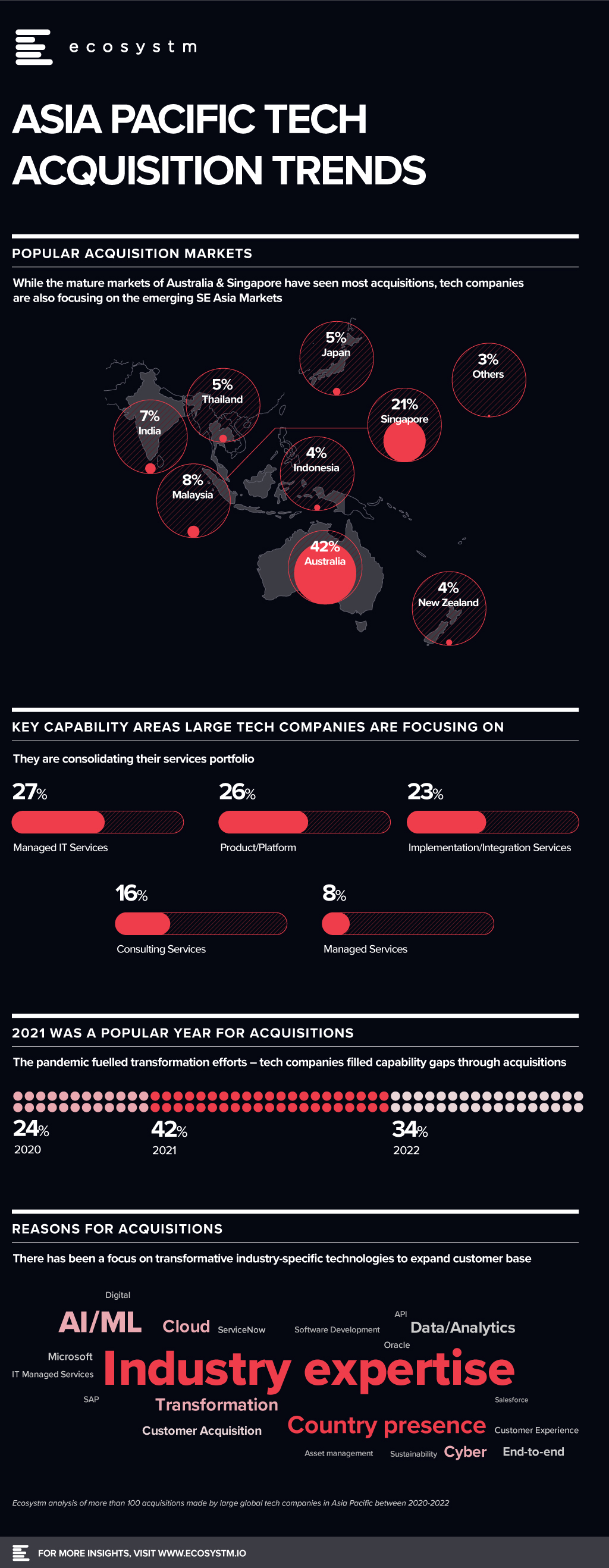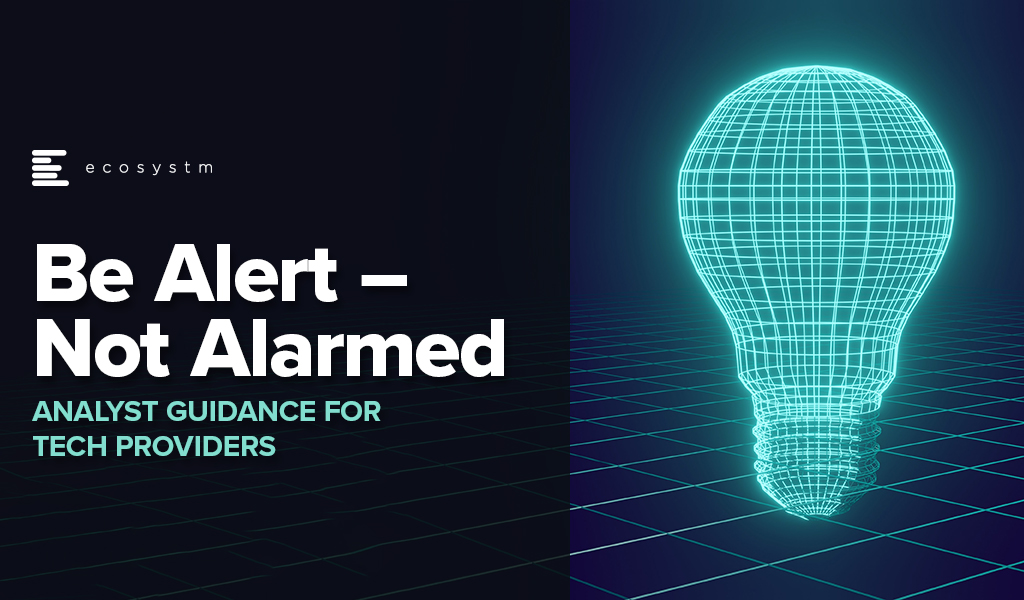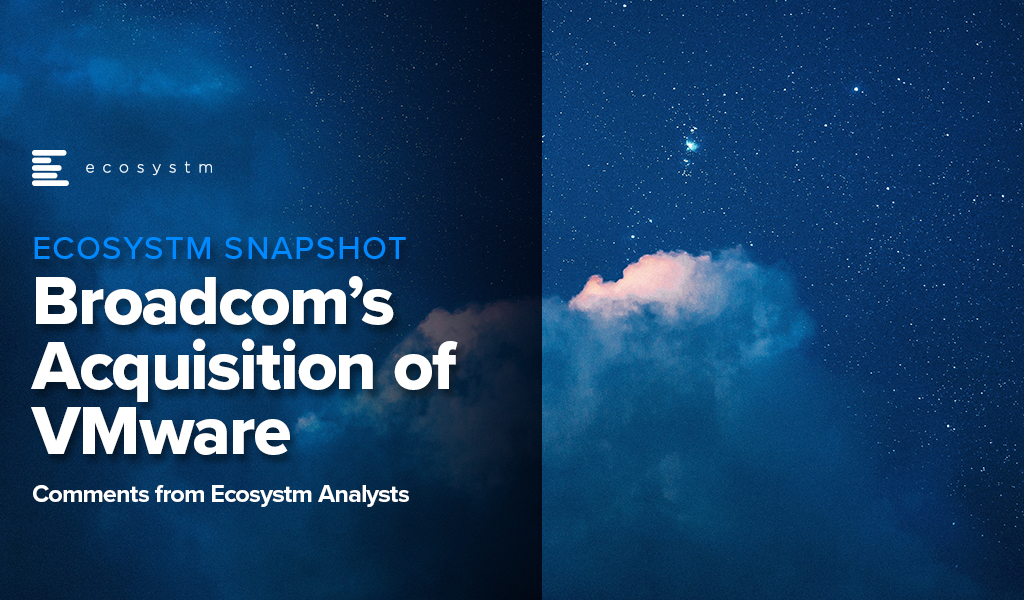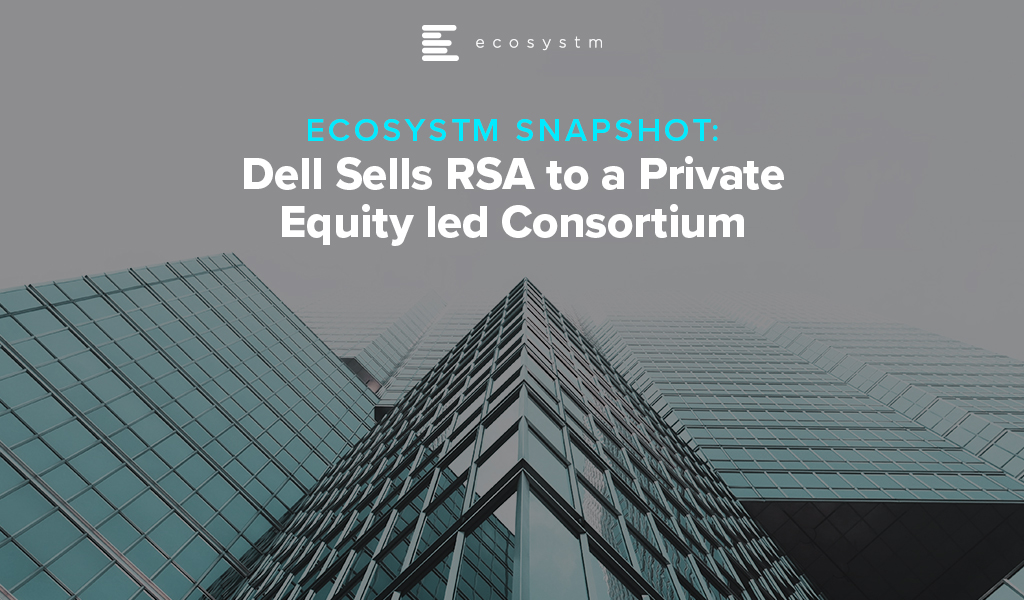As organisations demand more industry-ready and localised services, global technology companies feel an active need to re-evaluate their capabilities and bridge gaps through partnerships and acquisitions. Ecosystm has been helping global technology companies evolve their partner strategies to remain relevant to the Asia Pacific market.
Our analysis of the tech acquisition landscape in Asia Pacific over the last three years shows that:
- While global tech providers are expanding their presence in Australia and Singapore, emerging markets in Southeast Asia are receiving a fair share of attention. 17% of tech acquisitions by global tech companies between 2020-22 have been in these markets.
- A quarter of the acquisitions were for product and platform capabilities. The rest were all done to bolster services portfolios – such as managed technology, business process, implementation & integration and consulting services.
- A large percentage of the acquisitions are to bolster industry capabilities through transformative technologies such as AI/ML, cloud and cybersecurity.
Here is the analysis of more than 100 acquisitions made by large global tech companies in Asia Pacific between 2020-2022.

Download ‘Asia Pacific Tech Acquisition Trends’ as a PDF
There is no doubt that 2023 is off to an uncertain start. However, despite the economic headwinds we expect that some areas of technology will see continued growth. In fact, from our conversations with business and technology leaders, it appears that many organisations will take the opportunity to right-size their businesses, remove excess fat and waste, and accelerate their transformation efforts. The plan is to emerge from a global slowdown – leaner, smarter and better.
Where there is an opportunity to automate organisations will take it – and technology spend will trump people spend in 2023.
But it won’t all be smooth sailing as technology buyers become more discerning than ever and manage costs closely.
Here is what tech providers should focus on to remain resilient in these uncertain times.
- Be prepared to work harder – especially cloud and SaaS providers
- Help customers optimise costs
- Accelerate innovation to stay ahead of M&A activity
- Employ security to manage risk
- Prepare for product-led growth
Read on to find out why.
Download Be Alert – Not Alarmed: Analyst Guidance for Tech Providers as a PDF

Last month, Broadcom announced their intentions to acquire VMWare in a deal worth USD 61 billion – one of the biggest acquisitions in the tech world.
Broadcom has been actively looking to diversify away from their core business of chip manufacturing into enterprise software. Their previous acquisitions – CA Technologies for USD 18.9 billion in 2018, followed by Symantec for USD 10.7 billion the next year – have already indicated that. The VMware acquisition is the biggest – and arguably very different from the others.
Ecosystm Analysts, Alan Hesketh, Darian Bird, Niloy Mukherjee and Tim Sheedy comment on the implications for the companies and the market.
Download Ecosystm Snapshot: Broadcom’s Acquisition of VMware as a PDF

In the recently published the Top 5 Cybersecurity & Compliance Trends for 2021 report Ecosystm predicts that 2021 is when M&As will ramp up in earnest to consolidate the fragmented cybersecurity market. The pandemic has slowed down M&A activities in 2020. Early signs of what we can expect from the market when we emerge from COVID-19 can be seen in the recent acquisition of Asavie by Akamai Technologies. The market is realising the full implication of the shift to remote working and the potential of increased cyber threats – and this acquisition is a sign that larger vendors will continue to strengthen their cybersecurity capabilities by acquiring vendors, with complementary capabilities.
Asavie Enabling the Secure Office Anywhere
Asavie, headquartered in Ireland, offers a global platform that manages the security, performance, and access policies for mobile and internet-connected devices. Asavie delivers secure access to business resources for a mobile workforce – without requiring installation and management of client software. Increasing mobile workloads and Office Anywhere trends mean that the enterprise private network is no longer just PCs/laptops. All enterprise endpoints must be considered to be a part of the enterprise network – and security and authentication solutions must be able to handle this. Organisations will need to explore options where they can give seamless access to their employees without straining their IT and cybersecurity teams – a rapidly installable, scalable, and cloud-managed solution will become a necessity.
More than ever before, enterprises will have to treat all endpoints as branches of the organisation, and the Future of Work goes beyond enabling home offices. The Global CXO Study: The Future of the Secure Office Anywhere finds that 66% of IT and business leaders think of multiple locations, when they think of Office Anywhere. Employees will work wherever they get the best work experience and are most productive. Future work patterns will require that all endpoints are considered as extended branches of the organisation. This involves the ability to extend the enterprise WAN – with speed, flexibility, and security in mind – whether it is a temporary or a home office, an ad-hoc point of sales or an employee on the go. Every employee or device should be treated like a Branch of One.
Ecosystm Comments

“Akamai has been diversifying away from its well-known content delivery network (CDN) offering and has successfully built its security business offering in recent years. In 2019, the company nearly doubled its security revenue to USD 849 million from just USD 488 million in 2017. In their 3rd quarter financial results reported in end October 2020, the Cloud Security Solutions revenue was US$266 million, up 23% year-over-year.”
“The move into the mobile security segment has been timely for Akamai as enterprise application and content is moving from behind the firewall to the cloud; adding to the criticality of the cybersecurity threat management. The COVID-19 pandemic has further driven the onboarding of businesses and consumers alike, adding to significant addressable market opportunities.”
“The acquisition of Asavie is a strategic move. Asavie’s solution effectively extends the enterprise security management to incorporate mobile devices as a ‘Branch of One’ enabling CIOs and CISOs to manage security and policies the same way as traditional enterprise network resources. The growth of 5G will further drive IoT devices and a myriad of applications and use cases which will provide for a significant growth opportunity for Akamai – the acquisition of Asavie is a positive move to support this trend.”
Akamai Strengthens Intelligent Edge Capabilities
Asavie’s mobile, IoT and security solutions will integrate with Akamai’s Security and Personalisation Services (SPS) product line sold to carrier partners that embed the solution within the technology bundle sold to their subscribers. With the Asavie acquisition, Akamai intends to help their carrier partners address enterprise and mid-market customer demand for IoT and mobile device security and management services.
Ecosystm Comments

“The addition of Asavie to Akamai’s SPS product line provides synergy for the company to expand into new addressable markets for the remote workforce and internet-connected devices to deliver superior experience in a multi-cloud environment. The Global CXO Study conducted by Ecosystm found that three quarters of the organisations rate mobile security as an important or very important part of their digital transformation strategy. Secure mobile experiences will be a core element of the enterprise going forward in the post COVID-19 business environment – driven by employee needs for mobile services and corporate resources from remote locations, with superior identity and policy management, in a frictionless manner.”
“There is an opportunity for mobile service providers and mobile virtual network operators (MVNOs) to leverage the Asavie solution combined with Akamai’s strength at the edge with over 1,500 networks worldwide to offer cloud-based value-added cybersecurity services. The Global CXO Study also found that scaling of endpoint security was a major pain point for half the organisations with more than 100 branches. Service providers can become the enabler by offering services for small and medium enterprises (SMEs) to dynamically adapt their network and security services to fluctuating demand conditions.”

“Although Akamai does offer CDN services for the SME segment, the company heavily relies on service providers and carriers to address this segment in the CDN, cloud security and its burgeoning IoT Edge offerings. Asavie’s market approach is similar and its products and services portfolio appears to complement Akamai’s very well, making it a very good fit for the company. Not only will it enhance Akamai’s SME positioning on the secure connectivity space, but it will also boost its offerings for carriers in the IoT space.”
“Carriers have had a checkered history at best, in understanding and making the most of data services. Mobile Internet took off because of smartphone manufacturers (Apple) and Internet companies – not through carrier offerings. Although carriers appear to be more proactive and forward-looking with regards to IoT, they should not expect to have the foresight to see what services and business cases will make 5G and IoT truly profitable. Rather, their main focus should be on enabling the secure and flexible infrastructure that can ultimately enable others to develop the use cases. The next logical step would then be for carriers to develop IoT orchestration platforms that can manage much larger parts of the IoT value chain. If they succeed in this (and even if they don’t) it could result in a major boost for Akamai’s CDN business.”
“In other words, carriers need help with IoT and to that end, Akamai’s acquisition of Asavie may strengthen its ability to support carriers to reach that goal.”
The full findings and implications of The top 5 Cybersecurity & Compliance Trends For 2021 are available for download from the Ecosystm platform. Sign up for Free to download the report.

Ecosystm research finds that 47% of organisations re-evaluated cybersecurity risks and management making it the biggest measure undertaken by IT Teams when COVID-19 hit. There is no denying any more that cybersecurity is a key business enabler. This year witnessed cybercrime escalating in all parts of the world and several governments issued advisories warning enterprises and citizens of the increase in the threat landscape, during and post COVID-19. Against this backdrop, Ecosystm Advisors, Alex Woerndle, Andrew Milroy, Carl Woerndle and Claus Mortensen present the top 5 Ecosystm predictions for Cybersecurity & Compliance in 2021.
This is a summary of the predictions, the full report (including the implications) is available to download for free on the Ecosystm platform here.
The Top 5 Cybersecurity & Compliance Trends for 2021
- There will be Further Expansion of M&A Activities Through 2021 and Beyond
As predicted last year, the market is set to witness mergers and acquisitions (M&As) to consolidate the market. The pandemic has slowed down M&A activities in 2020. However, the market remains fragmented and there is a demand for consolidation. As the cyber market continues to mature, we expect M&A activities to ramp up over the next couple of years especially once we emerge from COVID-19. Some organisations that understand the full impact of the shift to remote working and the threats it creates have embraced the opportunity to acquire, based on perceived value due to COVID-19. The recent acquisition of Asavie by Akamai Technologies is a case in point. Asavie’s platform is expected to strengthen Akamai’s IoT and mobile device security and management services.
- After a Year of Pandemic Leniency, Regulators will Get Stricter in 2021
The regulators in the EU appear to have gone through a period of relative leniency or less activity during the first few months of the pandemic and have started to increase their efforts after the summer break. Expect regulators – even outside the EU – to step up their enforcement activities in 2021 and seek larger penalties for breaches.
Governments continue to evolve their Compliance policies across broader sectors, which will impact all industries. As an example, in Australia, the Federal Government has made changes to its definition of critical infrastructure, which brings mandates to many more organisations. Governments have shown an acute awareness of the rise in cyber-attacks highlighted by several high-profile breaches reported in mainstream media. Insider threats – highlighted by Tesla, where an employee raised the allegations of bribery by unknown third parties in exchange for exfiltrating corporate information – will also lead regulators to double down on their enforcement activities.
- The Zero Trust Model Will Gain Momentum
Remote working has challenged the traditional network security perimeter model. The use of personal and corporate devices to access the network via public networks and third-party clouds is creating more opportunity for attackers. Organisations have started turning to a Zero Trust security model to mitigate the risk, applying advanced authentication and continuous monitoring. We expect the adoption of the Zero Trust model to gain momentum through 2021. This will also see an increase in managed services around active security monitoring such as Threat Detection & Response and the increased adoption of authentication technologies. With an eye on the future, especially around quantum computing, authentication technologies will need to continually evolve.
- The Endpoint Will be the Weakest Link
The attack surface continues to grow exponentially, with the increase in remote working, IoT devices and multicloud environments. Remote endpoints require the same, if not higher levels of security than assets that sit within corporate firewalls, and it will become very clear to organisations that endpoints are the most vulnerable. Remote workers are often using unsecure home Wi-Fi connections and unpatched VPNs, and are increasingly vulnerable to phishing attacks. IoT device passwords are often so weak that brute-force attackers can enter networks in milliseconds.
Although endpoint security can be dealt with through strict policies together with hardware or software authentication, the difficult part is to adopt an approach that retains a relatively high level of security without having a too negative an impact on the employee experience. Experience shows that if the security measures are too cumbersome, employees will find ways to circumvent them.
- Hackers Will Turn the Table on AI Security
Cybersecurity vendors are increasingly offering solutions that leverage AI to identify and stop cyber-attacks with less human intervention than is typically expected or needed with traditional security approaches. AI can enhance cybersecurity by better predicting attacks enabling more proactive countermeasures, shortening response times, and potentially saving cybersecurity investment costs. The problem is that the exact same thing applies to the hackers. By leveraging AI, the costs and efforts needed to launch and coordinate large hacker attacks will also go down. Hackers can automate their attacks well beyond the use of botnets, target and customise their attacks with more granularity than before and can effectively target the biggest weakness of any IT security system – people.
Already, phishing attacks account for many of the breaches we see today typically by employees being tricked into sharing their IT credentials via email or over the phone. As we move forward, these types of attacks will become much more sophisticated. Many of the deepfake videos we see have been made using cheap or free AI-enabled apps that are easy enough for even a child to use. As we move into 2021, this ability to manipulate both video and audio will increasingly enable attackers to accurately impersonate individuals.

In the Top 5 Cybersecurity and Compliance Trends for 2020, Ecosystm predicted that 2020 will witness a significant uplift in mergers and acquisition (M&As) activities in the cybersecurity market. Like the consolidation activity in previous booms (such as digital media and web services in the early 2000s), the cybersecurity market is booming globally and creating opportunities for cashed up vendors and private equity firms. The fragmented security market has thousands of vendors and consultancies globally. Every day a swathe of new start-ups announces their ground-breaking new technology. Coupled with significant investments globally in tertiary education and industry certifications for a growing workforce, the next generation of cybersecurity entrepreneurs are entering with force.
Earlier this month, a consortium led by private equity firm Symphony Technology Group (STG) entered into an agreement with Dell Technologies to acquire RSA for an estimated amount of USD 2 billion. Dell Technologies had expressed interest in selling RSA in November 2019, and industry sources say that the deal will be finalised at more than their initial expectations.
Dell has been focusing on their partner program and on simplifying their product portfolio offerings. The Dell Technologies Partner Program announced last year, allows enterprises to seamlessly access partner products and solutions. Regardless of the partner, all solutions under the Dell portfolio count toward the tier status and tier revenue requirements for clients. Selling RSA allows them to streamline their product portfolio and by their own assertion, Dell has not lost focus on the significance of cybersecurity. They reinforced their commitment to build automated and intelligent security into infrastructure, platforms and devices. Claus Mortensen, Principal Analyst Ecosystm says, “Dell never really figured out what to do with RSA or how to position RSA’s products relative to Dell’s and VMWare’s own products. For example, Dell has its own endpoint protection product with SecureWorks and this has a great deal of overlap with RSA.”
RSA has been one of the pathbreakers in the cybersecurity market with their SecurID offering. They also host the largest security conference. RSA Conference gets together leading experts from across the industry to discuss the current trends and challenges, as well as shape the industry through innovations. Talking about the impact of the acquisition on RSA’s brand image, Mortensen says, “It depends on what STG intends to do with the company going forward. Arguably, RSA has been a bit in the shadows of previous owners – EMC and Dell – but if the new owners have a distinct plan for RSA, the brand will benefit”.
The members of the consortium acquiring RSA is interesting in its diversity. It includes the Ontario Teachers’ Pension Plan Board (Ontario Teachers’) and AlpInvest, another private equity firm. STG’s recent acquisitions include RedSeal, a security risk management provider. Mortensen predicts that the key player in this consortium will be STG, who will bring the know-how as well as money to the table. “Ontario Teachers’ and AlpInvest appear to primarily be financial backers. In fact, less involved these two partners are in the management of RSA, the easier it will be to secure a steady future focus for the company.”
As Ecosystm has observed previously, private equity firms will play a role in consolidating the cybersecurity market. “RSA is an almost textbook candidate for an equity firm or an investment bank takeover – a company with a good line of products but with a lack of strategic focus or leadership,” says Mortensen. “If STG can provide that focus – and from that USD 2 billion payment, one would assume that they can – they should have a good chance of increasing the value of RSA. If not, chances are that RSA’s products will be sold off piecemeal in the years to come.”


























